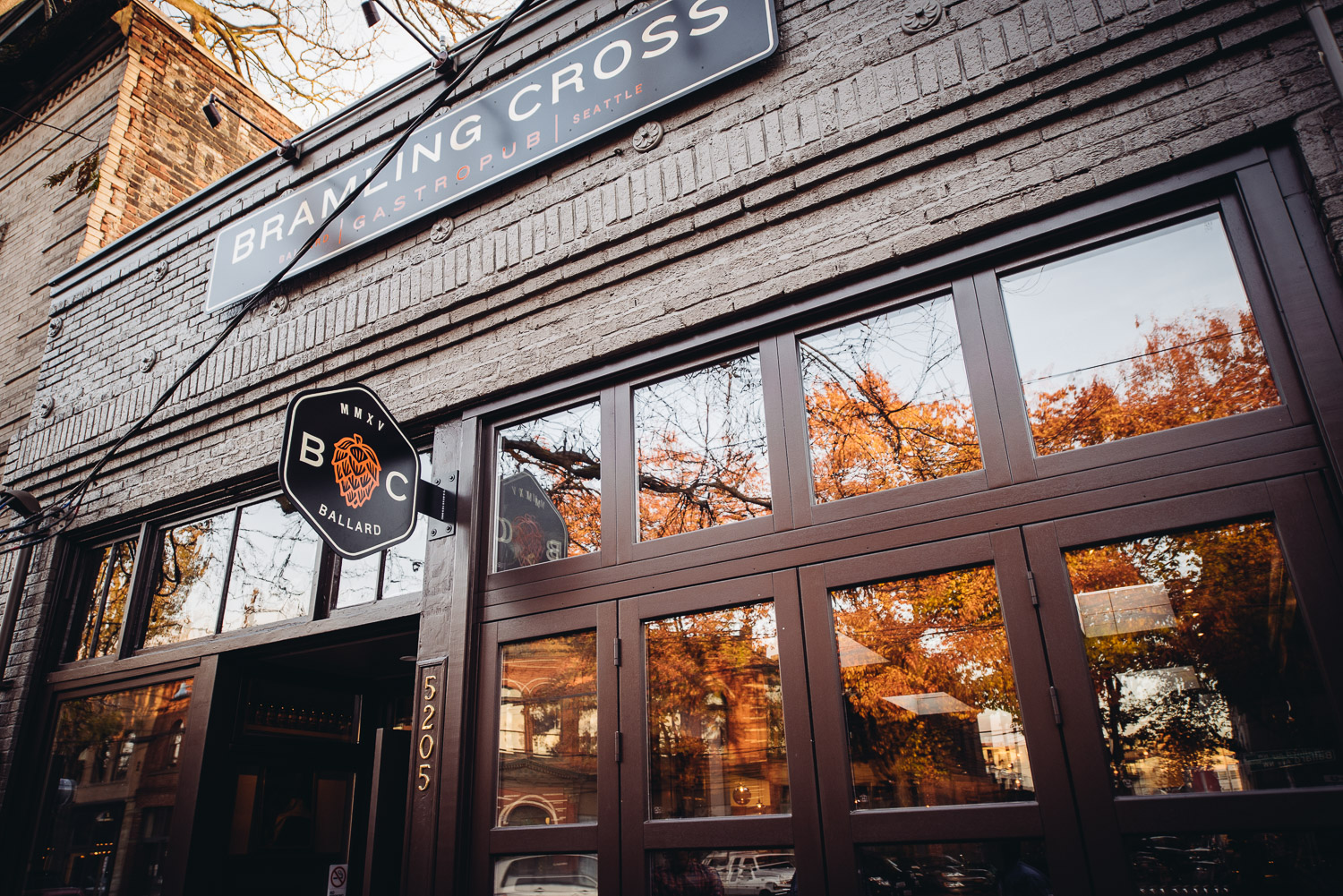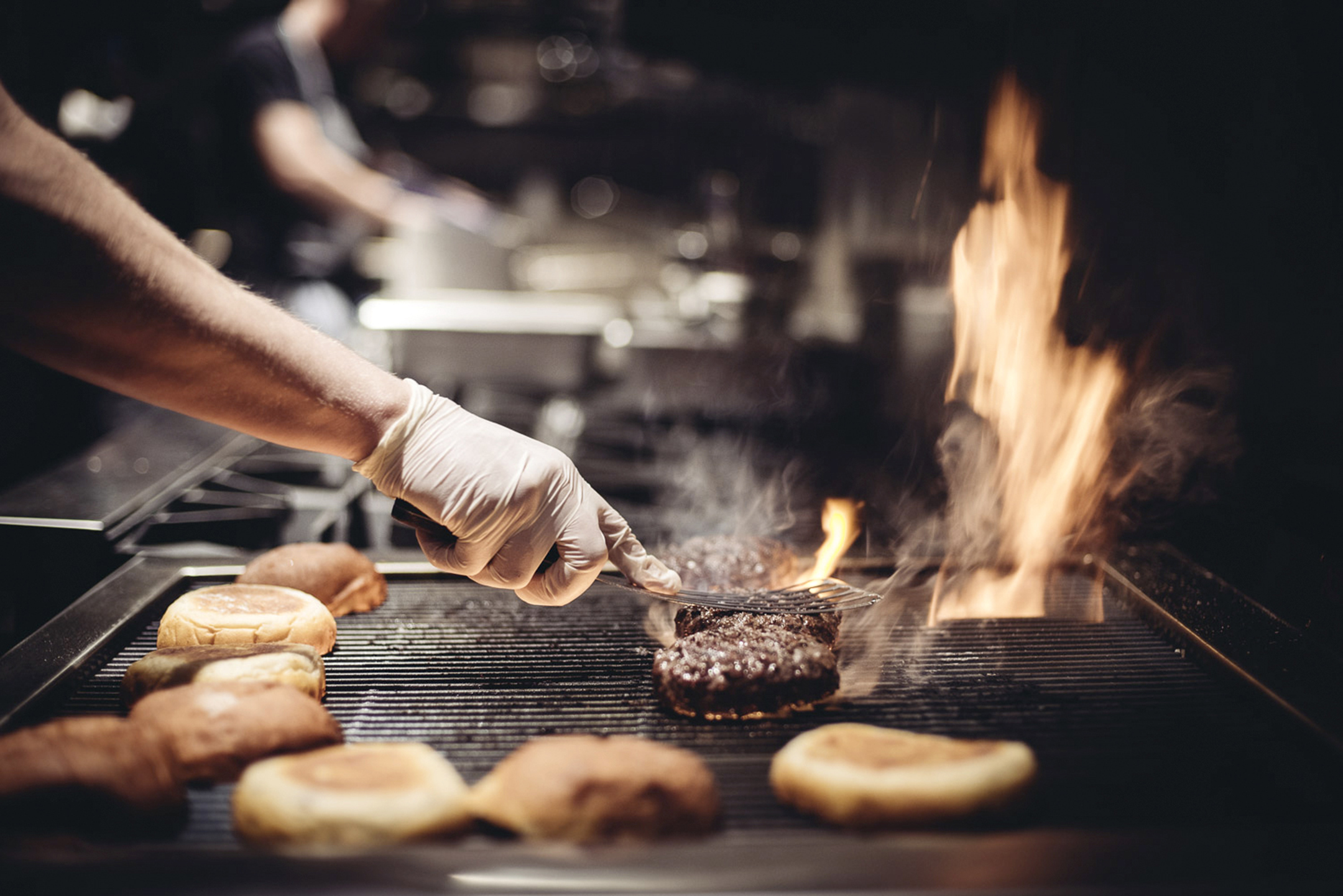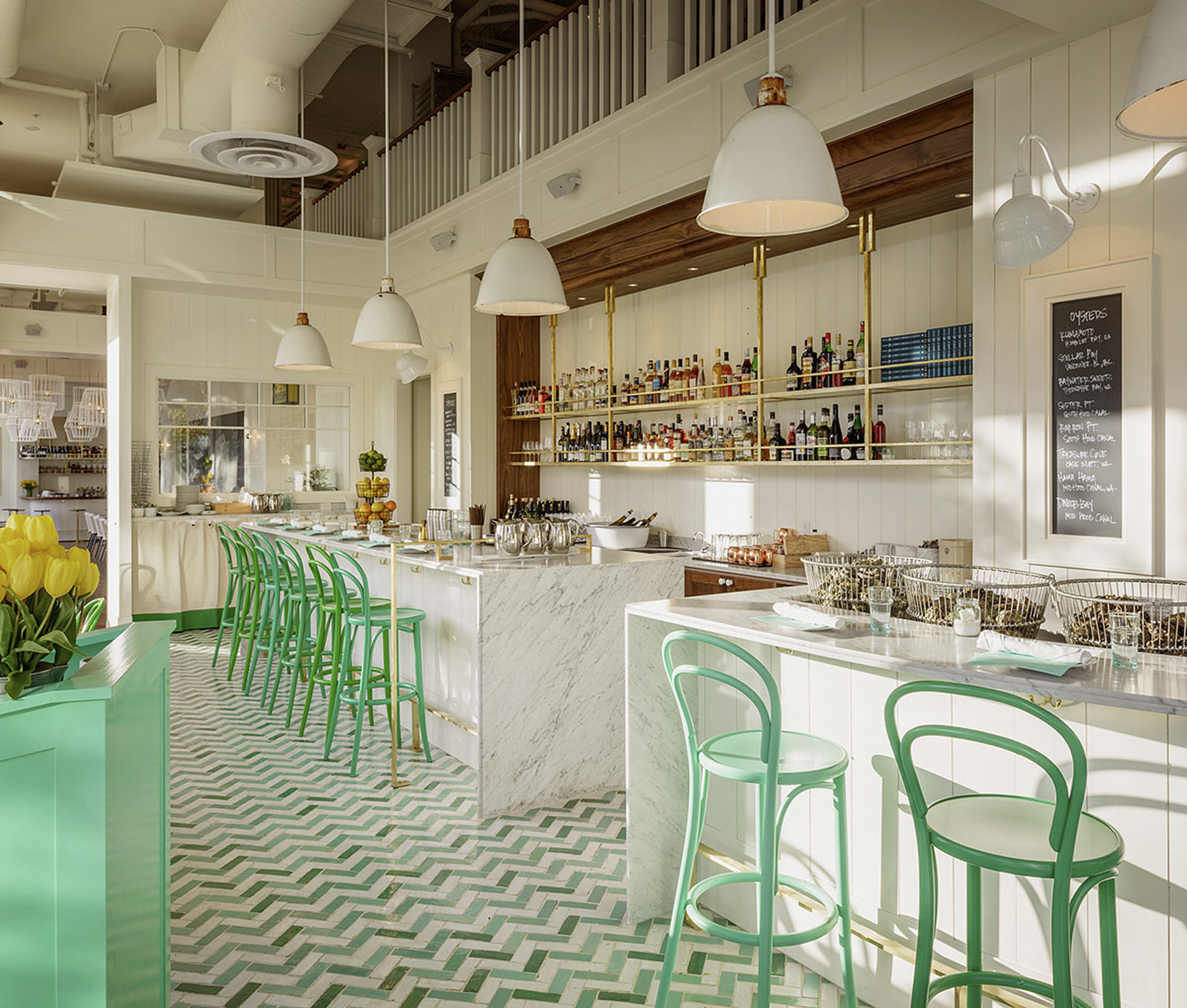Clockwise from top: Interior window sketches of Roberto’s Venetian Trattoria, the slow bar at Ballard Coffee Works, and Atelier Drome’s Henry Walters and Michelle Linden.
These days, we take it for granted that the restaurants we flock to will come with a handsomely appointed interior. Without the requisite charming ambience, even the best food may not alone draw us. But an inviting interior doesn’t come out of thin air; it’s the result of months and months of talks and labor between chef/owner and architect/designer—a process that diners rarely get any peek into. Until now.
We asked local design firm Atelier Drome to give you a look at how a restaurant is made. The firm specializes in (among other things) restaurant design, with high-profile clients like Ethan Stowell, Nathan Lockwood, and others. From envisioning a concept to refining it and eventually constructing it, principals Henry Walters and Michelle Linden took us behind the scenes, with lots of anecdotes, sketches, and photos from real restaurants and coffee shops they’ve worked on.
ENVISIONING
Seattle Weekly: A successful restaurant has a signature look and feel that gels with its overall concept—the story it’s trying to tell. Often a restaurateur knows what the story is, but isn’t sure how to translate that into a look. Can you give us an example of how you helped a client integrate their design with their story?
Atelier Drome: We’re currently working on a few modifications for Seattle Coffee Works’ Pike Street location. SCW prides itself on its intelligent and ethical approach to coffee, which is evident in both their farm-to-cup philosophy (directly sourcing and roasting the beans) and their wide range of methods for making the coffee. From a design standpoint, we want to help inform their clientele about their ethical and distinctively delicious approaches to sourcing, roasting, and making coffee that distinguish SCW from your average coffee shop.
They have a “slow bar,” which is a separate section of the cafe where customers can learn about and taste-test the various methodologies. Right now, though, the slow bar is a bit hidden from view, so we’re organizing the signage, artwork (including photos of the farmers SCW works with), and seating at the slow bar to more clearly distinguish it as a place for enjoying and learning about coffee.
What about actually finding a spot? It seems like more people are looking to open restaurants, but availability is increasingly scarce. As architect/designers, how do you go about sourcing a location that meets a restaurant’s needs?
We often work with clients before they’ve even signed a lease to determine if a space is right for them. Before signing the lease for Roberto’s Venetian Trattoria, soon to open in Pike Place Market, we worked with the client on schematic designs for three other downtown spaces. While working through the various options, we were able to compare seat counts, pedestrian traffic, view corridors, and general branding of the various spaces. Ultimately, we were able to help show how much more compelling the space at the market would be. For example, while its layout actually had a slightly smaller seat count (though we were able to maximize it with the addition of an outdoor dining pavilion), the amazing views of the water, foot-traffic patterns in the market, and a structure visible beyond the walls of its own restaurant (therefore increasing visibility and interest of passersby) gave it the advantage over the other spaces.
Clockwise from top: Roberto’s Venetian Trattoria exterior, Pettirosa’s salvaged old gymnasium lights from Second Use, and wood and steel chairs fabricated by Red Soul for Ballard Pizza Works.
REFINING
Once your client has found their dream location, I imagine there’s quite a bit of red tape in the form of approvals, leases, city code standards . . . What’s one of the most challenging spots you’ve had to deal with in this regard?
Roberto’s has been a complex build-out. In addition to the remodel of a space within an existing historical building, we also designed a new modern steel-and-glass outdoor dining pavilion and had to demonstrate via 3-D models that it would not block views of the historic Public Market sign visible along the Hillclimb and Western Avenue. Working with the Market itself was particularly demanding, as we had to present all of our designs, plans, and 3-D models for review and approval before even applying for building and health permits. We feel proud that we were able to design the first new ground-up construction in the market in many years.
I’ve been to a lot of restaurants lately which tout some original or found objects that they incorporated into the design scheme. The idea of recycling is very popular right now. Have you ever worked on a project that inspired you to use some of the existing interior elements?
Many of our clients are eager to add salvaged materials, fixtures, or appliances to their projects. We’ve taken many treasure-hunting trips to local salvage shops, such as Second Use and Earthwise. While Pettirosso Seattle was under construction, we discovered four old gymnasium lights at Second Use that we knew needed a loving home. We convinced owners Miki and Yuki Sodos to purchase these giant caged lights, which are now a fantastic and unexpected feature in the main dining area.
What about collaboration? Besides contractors, whom else do you enlist to help bring a restaurant space to life?
We feel really lucky to collaborate with some fantastic clients, contractors, and craftsmen. One of our favorites is Red Soul, a steel fabricator near Georgetown. We’ve worked with them designing/building wood and steel chairs for Ballard Pizza Works, as well as steel bench legs and table bases for Rione XIII, Staple and Fancy, and more. The guys at Red Soul got their start working on high-end custom choppers—which is a very different clientele than the average architectural fabricator . . . But they’re great at what they do, super-creative, and a lot of fun to work with.
Tell me about a design challenge that wasn’t typical for you.
When Ethan Stowell came to us to design Bar Cotto, he wanted the space to be a younger, brighter sibling to next door’s Anchovies & Olives, and he wanted both restaurants to connect physically and visually, as well as share restrooms, prep areas, and a walk-in cooler. We went back and forth on a variety of ways to connect the two spaces (even though their designs are totally different) without causing problems with sound or light in either space. Eventually, we came up with a design for custom steel-and-glass pivoting windows. These very heavy windows are balanced so that they’re simple to operate. When closed, the windows still provide a visual connection, but when open, the two spaces become linked, even though you’re still in separate spaces.
Clockwise from top: Pendant lights created from yoga balls hang at Car Cotto, Pettirosa’s 50-year-old “secret” room, Staple & Fancy’s open kitchen for rock star chefs, and Bar Cotto and Anchovies & Olives shared window.
CONSTRUCTING
I imagine you work on a lot of older, even historic buildings. What are some of the “surprises” you’ve stumbled upon in the process of constructing a restaurant space from a long-standing spot?
Sometimes when working in old buildings, we discover something totally unexpected. During construction of Pettirosso, we found a room that had been boarded up and forgotten for at least 50 years! It still featured vintage wall coverings and light fixtures, and while we will never find out why it was covered up, we’re sure glad we found it. After the space was uncovered, we were able to make modifications to the original design using the newly found space as a server and bus station, which enabled those items to be moved out of the dining room.
Besides designing a space and its interior elements, do you ever actually custom-make anything, or is that all left to various tradesmen?
As designers, we like to make objects with our hands that can inhabit the spaces we design. It gives us a more personal, tactile connection to our work, and is often an inexpensive way to add a sense of craft to the project. For Ethan Stowell’s Bar Cotto, we designed and built the three large central pendant lights in the space out of bailing wire, using a yoga ball as a form. We really love to make things and would love to do it even more—it brings us back to our model building roots.
Where do you see restaurant design headed in terms of new trends and styles?
During the recession, we saw a lot of small 20-to-30-seat neighborhood restaurants open up, many by first-time owners starting a new career. As the economy has started to power back up, we’re starting to see larger or more extravagant restaurants opening closer to downtown.
Restaurant design in Seattle is all over the map; however, we notice a tendency towards an honest expression of the building shell, the use of natural, even reused materials in new and creative ways, and a focus on local artisans and craftspeople and their process in the objects that inhabit the space.
A focus in most of our restaurants has been to open the kitchen to the dining room. Chefs are rock stars, and Seattle’s foodies are fascinated by their process of creating standout dishes. It’s very rare that we work on a closed kitchen anymore. The open kitchen is a stage, a form of entertainment that thrills and inspires. We hope that the boundaries between chef and diner continue to dissolve. As diners ourselves, when we go to a restaurant we want to understand the full experience of what is on our plate, and the more we can blur those lines, the more we all get a fuller experience.
What are you most excited about right now?
We particularly like how many restaurateurs and designers are re-envisioning how their spaces interact with each other and the public, by combining several culinary concepts together around a shared kitchen within an open-market atmosphere, such as Melrose Market and Via6.
We also love all of the pop-up restaurants happening throughout the city. The benefits of pop-ups are so huge. They allow new chefs and restaurateurs to take a chance and develop a name for themselves before making the full leap to a permanent home. In fact, many of our clients (Juicebox and La Bodega, for example) have started as pop-ups. But the benefit isn’t just for the chefs—the whole city is benefitting. Both new and established chefs are able to take chances that you just wouldn’t be able to do in a typical restaurant. We know there is a whole city of full bellies (ours included) thankful for these pop-ups.
The interesting thing about restaurant design is that while we all have come to expect good design from our restaurants, sometimes this means a design that really speaks to you, and other times the design is a quieter player that allows the restaurant to speak for itself. Both approaches are difficult in their own way, but in fact sometimes it can be harder to create a design that simply retreats to the background and allows you to enjoy the food and the company.
nsprinkle@seattleweekly.com







